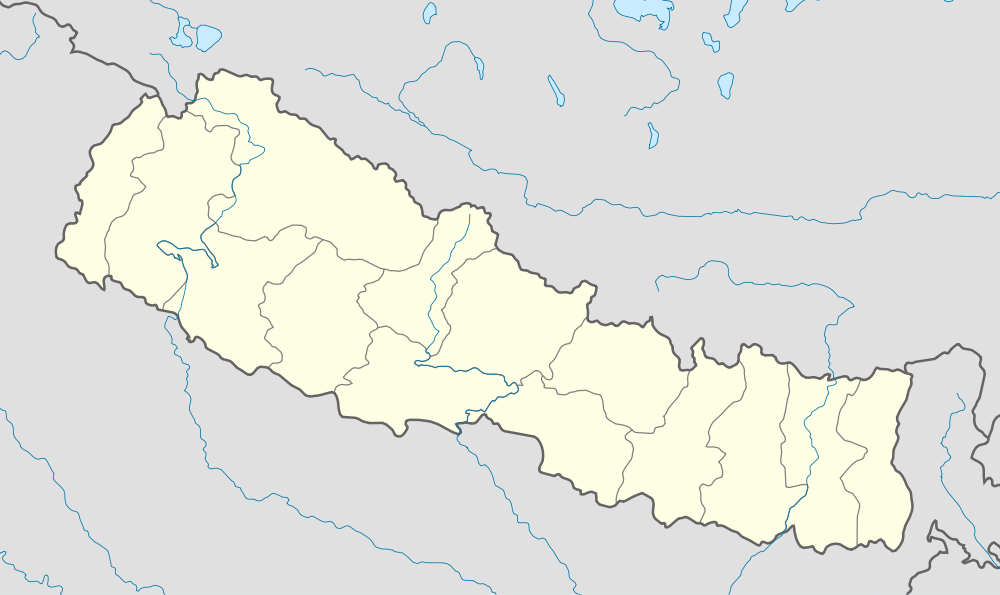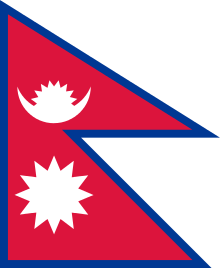Changu Narayan
| Changu Narayan (चाँगु नारायण) | |
|---|---|
|
Changu Narayan temple | |
 Changu Narayan (चाँगु नारायण) location in nepal | |
| Name | |
| Other names | Garuda Narayana |
| Proper name | चाँगुनारायण |
| Devanagari | चाँगु नारायण |
| Sanskrit transliteration | चम्पकनारायण |
| Geography | |
| Coordinates | 27°42′58.6″N 85°25′40.4″E / 27.716278°N 85.427889°ECoordinates: 27°42′58.6″N 85°25′40.4″E / 27.716278°N 85.427889°E |
| Country | Nepal |
| District | Bhaktapur |
| Locale | Changunarayan VDC |
| Culture | |
| Primary deity | Vishnu |
| Important festivals | Teej,Haribodani Ekadasi, Naag Panchami |
| Architecture | |
| Architectural styles | Pagoda |
| History and governance | |
| Creator | Haridatta Barma |
The ancient Hindu temple of Changu Narayan ![]() Listen is located on a high hilltop that is also known as Changu or Dolagiri. The temple was surrounded by forest with champak tree and a small village, known as Changu Village. The temple is located in Changunarayan VDC of Bhaktapur District, Nepal. This hill is about 8 miles east of Kathmandu and a few miles north of Bhaktapur. The Manahara River flows beside the hill. This shrine is dedicated to Lord Visnu and held in especial reverence by the Hindu people. This temple is considered as the oldest temple in Nepal.
Listen is located on a high hilltop that is also known as Changu or Dolagiri. The temple was surrounded by forest with champak tree and a small village, known as Changu Village. The temple is located in Changunarayan VDC of Bhaktapur District, Nepal. This hill is about 8 miles east of Kathmandu and a few miles north of Bhaktapur. The Manahara River flows beside the hill. This shrine is dedicated to Lord Visnu and held in especial reverence by the Hindu people. This temple is considered as the oldest temple in Nepal.
The Legend of Changu Narayan
In ancient times, a Gwala, or cow herder, had brought a cow from a Brahmin named Sudarshan. The cow was known for producing large quantities of milk. The Gwala used to take the cow to Changu for grazing. At that time Changu was a forest of Champak trees. While grazing, the cow always went to the shade of a particular tree. In the evening, when the Gwala took the cow home and started milking her, he got only a very small amount of milk. This continued several days. He grew very sad, so he called on the Brahmin saying the cow was not giving enough milk. After observing this with his own eyes, Sudarshan agreed with the Gwala they should observe the cow's daytime activity while she was grazing in the forest. Brahmin and Gwala both hid behind the trees and watched the cow. She went into the shade of one particular champak tree. To their surprise, a small black boy came out of the tree and started drinking the cow milk. The two men were furious because they thought the boy must be the devil and tree must be its home. So the Brahmin cut down the champak tree. When he was cutting it down, fresh human blood came out of the tree. Both Brahmin and Gwala got worried, believing they had committed a great crime and began to cry. Lord Vishnu emerged from the tree and told the Brahmin and cowherd it was not their fault. Vishnu told the story of how he had committed a heinous crime by unwittingly killing Sudarshan’s father while hunting in the forest. After that, cursed for the crime, he wandered the earth on his mouth, as ‘Garuda’ eventually descending on the hill at Changu. There he lived in anonymity, surviving on milk stolen from a cow. When Brahmin cut down the tree, Vishnu was beheaded, which freed Lord Vishnu from his sins. After hearing these words from Vishnu, Brahmin and Gwala resolved to worship the place and established a small temple in the name of Lord Vishnu. Ever since, the site has been sacred. Even today, we find Sudarshan's descendant as priest of the temple and the Gwala's descendants as ghutiyars (conservators). [1]
Physical Aspects
Changu Narayan Temple is situated at the top of the hill surrounded by forest of Champ tree. On the main way to temple courtyard, we can find human settlement. People from Newar community live in and around Changu Narayan area. With the development in tourism in this place, we can find many medium and small sized hotels, restaurants, souvenir shops, etc. An ancient stone tap is located on the way to Changunaran which is believed to have existed since the time of Lichhavi.
The Temple art and architecture
Changu Narayan is considered to be the oldest temple of Nepal. It remains a milestone in Nepali temple architecture with rich embossed works. The two-storey roofed temple stands on a high plinth of stone. According to Professor Madhan Rimal, Department of Sociology and Anthropology, Tribhuwan University, the temple is neither in Shikhara Style nor the Pagoda style. It has an architectural style which he would like to describe as a traditional Nepali temple. Many similar features are found at Gokarna Mahadev. The temple is surrounded by sculptures and arts related to Lord Vishnu. Also we can find the temples of lord Shiva, Ashta Matrika, Chhinnamasta, Kileshwor and Krishna inside the courtyard of main temple. There are four entrances to the temple and these gates are guarded by life size pairs of animals such as lions, sarabhas, graffins and elephants on each side of the entrances. The ten incarnations of Lord Vishnu and the other idols are carved in the struts, which support the roof. The entrance door is gilded with carvings of Nagas (snakes). On the main entrance gate (i.e. western entrance gate), we can find the Chakra, Sankha, Kamal and Khadga all at the top of a stone pillar. These stone pillars has inscription in Sanskrit. This inscription is considered to be the oldest inscription of Nepal and the stone inscription pillar was erected by Lichhavi King Manadeva in 464 AD. The following monument are located while visiting the temple from the right side after entering from the main entrance (Eastern gate) to courtyard.
- Historical pillar erected by Mandeva in 464 AD [2]
- Garuda:- flying vehicle of Lord Vishnu which has got a human face and is a devotee of Vishnu.
- Statue of Bhupalendra Malla, King of Kantipur and his queen BhuwanLakshmi.
- Chanda Narayan (Garuda Narayan):- 7th century stone sculpture of Vishnu riding on Garuda. This sculpture has been depicted in the 10 rupee paper note issued by Nepal Rastra Bank
- Sridhar Vishnu:- 9th century stone sculpture of Vishnu, Laxmi and Garuda which stands on the pedestals of various motifs.
- Vaikuntha Vishnu :- 16th century sculpture of Vishnu seated on the lalitason position on the six armed Garuda and Laxmi seated on the lap of Vishnu
- Chhinnamasta:- Temple dedicated to Chhinnamasta devi, who beheaded herself, offered her own blood to feed the hungry Dakini and Varnini.
- Vishworup:- 7th century stone sculpture- beautifully carved that depicts the scene from the Bhagwat Gita, in which Lord Krishna manifests his universal form to his devotee Arjun.
- Vishnu Vikrant :- 7th century sculpture of Trivikram Vishnu that depicts the scene of popular Hindu myth of Lord Vishnu and his beloved Bali Raja.
- Narasimha :- 7th century sculpture of Narasimha, an incarnation of Lord Vishnu, killing the demon King Hiranyakasyapa to save his beloved devotee Prahalad.
- Kileshwor:- small two storied temples of Lord Shiva, who is believed to have appeared in this place for the protection of the hill.
The main image in the sanctum is worshipped by Hindus as a Garuda Narayan, and by Buddhists as a Hariharihari Vahan Lokeshwara.[3][4] Only the priest is allowed to see the image.
Information Centre
There is an information centre at the entrance to Changu Village. They issue tickets to tourist. The information center has a public toilet for tourist. Also drinking water facilities is available for tourist. But the drink water facilities have not been managed properly. Only direct tap water is available there. According to Binaya Raj Shrestha, owner of Chagu Museum and the member of temple management committee, on an average 150 foreigners visit Changu.
Changu Museum
A private museum is also located on in the Changu Narayan on the way to temple. According to Binaya Raj Shrestha, the owner of the museum, it is the first private museum of Nepal and it has the collection of ancient coins, tools, arts and architectures. There is an excellent collection of ancient, historical, artistic, religious, archaeological, cultural and other rare objects. The museum has a good collection of ancient tools used by Newar family during the medieval period. It was established on the occasion of millennium year 2000 AD with the permission of Changu Narayan VDC. The entrance fee for Nepalese is NRs. 50 and NRs. 300 is charged for foreigner. On an average 35 visitors visit this museum in a day. Mostly foreigners and Nepali students visit this museum.
Ethnographic Museum
There is an ethnographic museum inside the building of the temple which incorporates both objects and photographs collected by Judith Davis. Entrance is INR. 250 for foreigners. There is also a small bookshop.
Festivals and Fairs
Since the ancient period, many festivals and fairs have been organized on various occasions. One of the main festivals of Changu is called Changu Narayan Jatra. The festival ‘Mahashanan’ held here as an important festival. On the day of ‘Jugadi Nawami’ and ‘Haribodhini Ekadashi’ special puja is conducted in Changu. Daily puja and aarati is not conducted in temple and on the occasion of family rituals, such as birthday, marriage, etc. local conduct not special puja in the temple.
Management Approaches
Changu Narayan Temple is on the list of world heritage sites. The valuable stone sculpture and ancient inscriptions have archeological, historical and cultural significance. Changu Narayan VDC is formed a committee called Changu Narayan Temple management Committee which is the responsible body to work for protection, preservation and management. Likewise the Department of Archeology and Palace Management Office, Bhaktapur has also provided assistance on the conservation and preservation of the temple. Many local youth clubs are involved in managing festivals, organizing awareness programs in and around temple area.
Threats/ Challenges
The Manohara stream has long seen rampant mining of sand and stones. Local administration have failed to control the mining activities. Because of the mining activities, the temple area has become prone to landslides. Due to overgrazing in the nearby forest, the chances of soil erosion and landslide are very high.
There is a challenge regarding the security of the unique sculptures. Also the temple is getting older so renovation is necessary. The tourist information center has not been managed properly and they have not maintained good records of tourists. The museum is not issuing ticket bills after payments are made by Nepali visitors. Although Changu is only 8 miles east of Kathmandu, bus service is still lacking which means a newly constructed road to Changu has failed to bring in a significant number of tourists.
References
External links
| Wikimedia Commons has media related to Changu Narayan. |
Gallery




_(8567805299).jpg)
.jpg)
.jpg) Manadevas Pillar
Manadevas Pillar
After 2015 earthquake photo gallery


 temple and the priest
temple and the priest Temple's Museum
Temple's Museum West side of temple
West side of temple

 stone tap at Chagunarayan
stone tap at Chagunarayan

| Wikimedia Commons has media related to World Heritage Sites in Nepal. |
.jpg)
